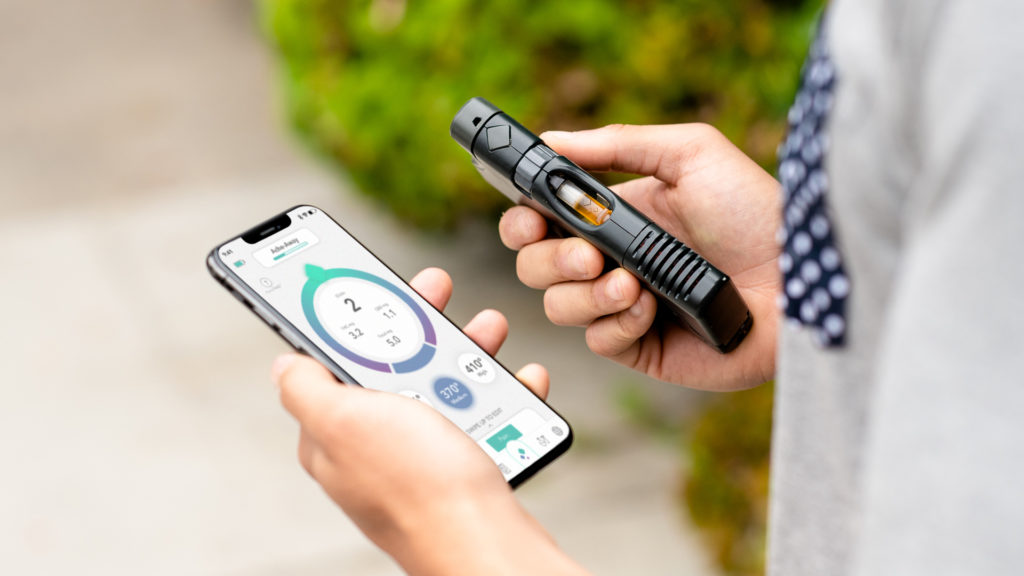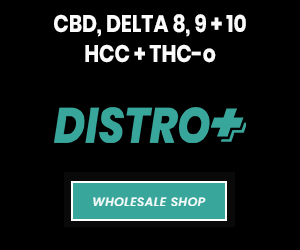
Rachelle Gordon
October 28th, 2019
Exclusive, News
In the world of cannabis, precision dosing is crucial in order to obtain the results desired. This is especially true for medical patients. And with so much talk in the news regarding vaping, it’s more important than ever for consumers to have a safe, reliable product. Enter Gofire, a company dedicated to helping people find their perfect alternative medicine regimen. Offering a full suite of community-centered products, including a smart inhaler, a dosing app, and a QR-code enabled catalogue of 3,000 partner products, Gofire aims to eliminate the guesswork that tends to come with medical marijuana.
CFN Media recently spoke with Gofire CEO and Founder Peter Calfee about how the business came to be, how they’re revolutionizing the way people use cannabis medicine, and what’s on deck for one of the most innovative companies in the alternative medicine space.
CFN Media: How was Gofire developed?
Peter Calfee: We set out on December 18th, 2014 to solve the problems of inconsistencies within the (cannabis) marketplace. We wanted to enable a consumer to quantify their consumption. When you go out to the store and you buy a bottle of Advil, you’re buying 30 capsules and each capsule contains 250 milligrams of ibuprofen. I know that I only need one to make my headache go away, whereas my girlfriend will take three to achieve the same effect.
The first step of the process was to create a consistent dose. So I sat down with my co-founder John Woodbine, and we had this concept of creating essentially a threaded syringe where we could do physical extrusion of the product out of the nozzle of a cartridge – similar to a syringe – and extrude that oil onto a gold screen and then utilize a true convection system to send heated air over and through the product that was extruded.
It took us about four months to develop that system. We realized that the accuracy from a dosing standpoint was pretty much between 2.45 to 2.55 milligrams per dose. So we’re talking about a very, very active pharmaceutical level of accuracy.
That being said, we realized that a dose is not a dose without the chemical profile associated with that dose. The analogy I like to use is lemonade and lemon juice. Eight ounces of lemonade is not eight ounces of lemon juice. There is a formula that makes up that lemonade, right? And so when we talk about 2.5 milligrams, we really want to say 2.5 milligrams of what? And so that’s when we created the idea of a “smart cartridge.”.
There’s a little microchip on the back of our cartridge. When you drop it into the device, the device recognizes a unique ID number, calls out to the server through the smartphone app, and that server then kicks back the third-party lab test results or COA (Certificate of Analysis) associated with that specific batch of product.
This allows us to now know the chemical profile of the dose. Again, with the precise dosage and chemical profile paired together, we can actually start creating consistent, repeatable experiences and give that control back to the patient, removing the fear of taking too much and being out of control, and allowing them to see that consistent, repeatable experience that they would demand and expect with any other medicine they’re putting into their body.
As we locked down dosing and chemical profile, we realized that when we talk about enabling the prescription pad, we had to communicate in a language that a patient and physician understood. If we think about what’s on a prescription pad, we have a dose, we have a chemical profile and we have a regimen, right? I want you to take this much of this particular drug, this many times a day. And that allows for a physician to be involved in that relationship, to tailor the protocols for that patient with a goal of a successful outcome in mind, and obviously tweak that protocol based on the outcome that that patient is experiencing.
So this platform that we’ve created is made up of the metered-dose inhaler as well as the smartphone application, which allows you to track your consumption and search by ailment, which actually helps you find products available in the market that works for that ailment. For the first time you can take an inexperienced consumer stepping into the space and give them the tools to make them feel comfortable and put them back in control, probably even more control than they would see with other, mainstream market pharmaceuticals they are used to consuming.
As we expanded, we realized we needed this to work for more than just the inhalable products out there. So we expanded again to create the Gofire DoseCode, our branded QR code, which allows patients to track the use and effects of products outside of inhalables, like topicals, sublinguals and edibles.
The system works very simply in the sense that consumers can just scan the Gofire DoseCode on a product or scan that UPC barcode of a product and then access that product’s chemical formulation within the app, indicate how much they’re taking and record their experience. We collect this anonymous post-purchase consumer use feedback. And I stress the word anonymous. The entire platform is anonymous. We do not know who these individuals are that are on the platform. Everyone is assigned a unique ID number, but we’re actually able to use that crowdsourced information, and provide that back to the consumers and patients. So again, the goal in mind being to help them find a product that will work best for them.
For example, someone who’s looking for medicine to help with their PTSD can lean on the Gofire community, search for PTSD and be provided with a list of products that has worked for others struggling with PTSD. So the patient will find a product has been rated 732 times with a 4.8 star rating for PTSD and be able to think, “Well maybe that’s a good place for me to start” versus just shooting in the dark and asking a budtender.
So the goal, again being to bring a little bit more transparency and connectivity, not just connecting a consumer to the delivery mechanism, but actually connecting that consumer with other consumers that are dealing with similar use cases. And the goal in mind being able to provide better care.
On the other side, we’re also able to take this anonymized data and pass it back to the companies that are actually making these different formulations to give them insight into how they are actually working in the market. If they’re trying to build something that’s going to help with sleep and insomnia, well how do we actually run a study? And say we’ve looked at again, 5,000 people that have consumed your product. It’s really actually not helping for sleep. We can help tailor again through batch to batch to batch help them build better products, more suited to the specific needs of the consumer and patient.
CFN: How will the data you collect, and the device in general, change the face of medical cannabis?
PC: I think there’s two pieces to the puzzle here. One is this system of consistency and control enables researchers to actually set up studies and run trials that can be peer reviewed because they have absolute control over the variables within each medicating session. That’s going to expedite the research that’s coming out on this plant and therefore continue to validate and expose the pros and cons of this plant so that again, physicians and patients can receive better care.
I think the other side of it is we’re actually for the first time starting to understand how these masses of products being released in the marketplace are affecting consumers. This is both on the negative and positive side. At the end of the day, we’re dealing with a very complex plant made up of hundreds of different chemical compounds. This is not a standard pharma play in the sense that we’re going to identify one to three specific chemical compounds that are going to address pain. Again, in the sense of mainstream pharmaceutical markets, we’ve got a raptness of chemical compounds here. Because of the entourage effect, we want to encourage that raptness, but we want to also understand the effects it will have.
I think, again, because of this concept of crowdsourced education among a connected community, the effect will be better care and better outcomes for patients in need. I also believe that because we’ve created this consistent, reliable means of providing a dose, we will see more mainstream adoption.
For the first time, any curious adult can actually come in and say, “Okay, I know exactly how much I need to take without being an experienced consumer. I know exactly how much I need to take to make me feel a certain way, and so that I’m no longer in pain, but I’m not bombed and I can still make it to my child’s softball game.” Now, this is really important when we look at mainstream market adoption of this industry as a whole.
CFN: The so-called “vape crisis” is getting a lot of media attention. How do you respond?
PC: I’ve been screaming about the concerns of vaping for five years. The biggest concern was always metal particulates and heavy metals leaching into the oil because you’ve got your heating element that’s sitting in that reservoir of oil. This was a problem that we actually talked about the night that Gofire was founded: How do we solve that problem and remove the heating element from that main reservoir, and therefore remove and mitigate the fear of any heavy metal leaching coming from the hardware itself? When we talk about that threaded syringe, that extrusion technology, if you look at our cartridge, our cartridge does not have a heating element in it.
We designed it this way because we knew that this was a considerable concern. I’m frustrated that it’s taken multiple deaths and hundreds of people getting sick for people to start listening and saying, “Wow, you’re right. This is a big concern. So how do we fix it?”
The other big concern is these additives that are being introduced. We see vitamin E, and we see propylene glycol. Back in the day it was PEG and BG. We’ve also seen MCT oil, which is hydrogenated coconut oil.
I think part of it is that the industry as a whole has been looking for solutions and regulations have not caught up to speed. Because of that, I truly believe it falls on the business owners within the space to regulate themselves until those regulations do catch up to speed. So, one of the things that we have built into our platform to solve for this is one, we have contracts and audits that are run on our filling partners to make sure that there are no additives or excipients being introduced into the solutions with it that are being filled into our cartridges.
From day one, this has been a big piece of our puzzle and the demand that we’ve made of all of our partners. Outside of that, because we have that smart cartridge, it allows us to actually again pull up a third-party report and verify exactly what’s in the cartridge. This information is again, validated, that there’s no fraudulent oil being introduced into any of our cartridges. We have those protections in place.
I think finally, now we’re in a place where everyone is waking up and saying this is something we need to look at and this is something that we need to make sure that product is being introduced into the marketplace. Especially when we looked at these emerging markets with the uneducated consumer, that we are providing, again, safe and efficacious products to the masses.
I quote my grandmother often, but she used to always say, “If you have the tools, you have a moral obligation to leave the world a better place than you found it.” It all comes down to responsibility. This really falls on the business owners to be driving these audits, and making sure they’re providing safe products to their consumer. It’s a moral obligation. That’s the bottom line.
CFN: How does the QR code on partner packages enter the business model?
PC: Between the QR codes and barcodes, I want to say we have more than 3,000 products on the platform, which makes up about 400 different brands. The Gofire DoseCode is a batch-specific QR code that goes on to these different packages of different products. And that again allows consumers to scan the code and see essentially the exact makeup of what’s contained within that product.
Batch specificity is crucial. Even if a product has the same name under the same brands batch to batch to batch, we see considerable inconsistencies. So, that DoseCode is batch specific, and allows for that consumer to scan it into our app, rate the products for how well it works for their pain, sleep, anxiety, PTSD (whatever use case they’re using it for) and start tracking and logging, again, the efficacy of that product. One step lower than that from a data value perspective is the barcode.
Now what’s cool about this barcode and what’s exciting about this system is it actually gives consumers the ability to tell us what products they want to track. So if you scan any barcode of any product in the marketplace and it does not yet exist in our backend on our server side, we actually ask you as a consumer to support us and your community by taking a few photos of that product. It will prompt you again if it doesn’t recognize the barcode, it just prompts you right there in the app. It’ll say, “Take a photo of the front of the packaging. Take a photo of the nutritional facts. Take a photo of the back of the packaging.”
We have someone on the backend who is taking that information and uploading it into the database. And within about 72 hours at most, that product will then be live on the platform and you can track that product and others can track that product. Again, really putting this back in the hands of the consumer to use the tool as they see fit.
We understand that different modalities are important for even within one regimen, depending on the situation. And we wanted to make sure that we were providing a full service health suite in our Gofire Ecosystem, providing access into any modality that might be part of your dosing regimen.
The iOS app is live in the app store. The Android is coming out within the next couple of weeks. But it really allows you as a consumer to tell us which products you want to track, and give you back that control.
CFN: What does the next 18 months hold for Gofire?
PC: You know what I can say is we’re just getting started. We believe that the future of connected health and connected medicine will give considerable insights. Again, not just within the alternative health space. From a data perspective, understanding or having early warning signs, essentially being able to send up a red flag when a patient is over-consuming, or under consuming, or misusing a product, or I say most importantly showing the low efficacy. “It’s not working. I’m still in pain. I still can’t sleep.” This is when the patient takes the wheel and says, “I’m going to take a little bit more.” Or, “I’m going to take a little bit less.” Or “I’m going to take it every three hours, not every four hours.”
We believe that the systems we are developing will act as an early warning sign for that physician and patient relationship and will allow tweaks to that regimen be done in real time providing better care.
On the hardware side, all you can say is we’re not stopping. We realize that the product that we’ve released is really a premium product and there’s a huge demand for some of these more inexpensive products in the marketplace. We are aware of that, and have been working on something that will suit that need. Although at this time I can’t go much deeper into it. I’m sure in the next story we do we’ll be able to shed a little more light on that.
CFN: Your IP game is some of the strongest in the space. Are your competitors nervous?
PC: Our intellectual property is something that we pride ourselves on. At this point, we file every, call it, 60 days. The innovations that are coming out of my team knock my socks off. I’m a lucky guy to work with these brilliant minds. I think a big piece from an IP perspective is we understand that we move faster and we started earlier than many of the other companies within the space, and it gave us an advantage from an IP perspective.
I will say to any company out there that is interested in working with us and is running into blockades because of our intellectual property, reach out to us. We’re in the business of impact and that means we want to support other companies and other brands that want to provide superior technology to the current product offerings in the marketplace. So, I guess what I’m saying is we know we’ve got quite the IP portrait, but if anyone’s interested in knocking on that door and wants to play with us, we’re all about it.
CFN: What else should our readers know about Gofire?
PC: I’d say in general we are a small team of scrappy individuals. We work like we are four times the size of what we are. Our team is incentivized; we are in a sense employee owned. So every single one of my employees is underpaid and makes up their comp package in stock in the company options in the company.
What I love about this as the leader is we’re all incentivized together. We’re not here for a paycheck. We’re here for impact, and we’re here because we know that at some point in the near future we will see multiple liquidity events. And that is when I get paid as the CEO and founder. And that is when my employees and my team gets paid. And that is when my investors get paid. There’s a collaborative deal behind this company as a private equity investor myself, I’ve never seen to the extent that I see with our company.
My biggest thing is we’re in a unique opportunity within this business where I think the applications of what we’re developing within this space, we’re looking at this industry as our sandbox. Where we will be going is again applying some of these systems and tools to mainstream medicine. At the end of the day, connecting patients, physicians, drug manufacturers, and payers with better optics to make more informed business decisions.
If you look at the data space, the most valuable data you can collect in any industry is how a consumer interacts with the product. For some odd reason within the alternative health space that just doesn’t exist. What’s even more disturbing I would say is that when we look at the healthcare and pharmaceutical space, that data doesn’t exist.
That is why we are in an opiate epidemic. Because we would have known if we had systems like Gofire in place, we would have known within 20 days of the products being released that there was considerable cases of misuse that would lead to addiction. And we would have been able to be proactive versus reactive within the marketplace.
I think this is what the mainstream medicine market needs to come out of the 20th century and step into the future of connected health.
To learn more about cannabis innovation, sign up for our free newsletter using the form to the right.
This article was published by CFN Enterprises Inc. (OTCQB: CNFN), owner and operator of CFN Media, the industry’s leading agency and digital financial media network dedicated to the burgeoning CBD and legal cannabis industries. Call +1 (833) 420-CNFN for more information.
About Rachelle Gordon
Rachelle Gordon is a Minneapolis-based writer. Find her online at www.rachellegordon.net.
MJ Shareholders
MJShareholders.com is the largest dedicated financial network and leading corporate communications firm serving the legal cannabis industry. Our network aims to connect public marijuana companies with these focused cannabis audiences across the US and Canada that are critical for growth: Short and long term cannabis investors Active funding sources Mainstream media Business leaders Cannabis consumers










